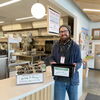Processing Your Payment
Please do not leave this page until complete. This can take a few moments.
- News
-
Editions
-
- Lists
-
Viewpoints
-
Our Events
-
Event Info
- Women's Leadership Forum 2025
- On the Road with Mainebiz in Bethel
- Health Care Forum 2025
- On The Road with Mainebiz in Greenville
- On The Road with Mainebiz in Waterville
- Small Business Forum 2025
- Outstanding Women in Business Reception 2025
- On The Road with Mainebiz in Bath
- 60 Ideas in 60 Minutes Portland 2025
- 40 Under 40 Awards Reception 2025
- On The Road with Mainebiz in Lewiston / Auburn
- 60 Ideas in 60 Minutes Bangor 2025
Award Honorees
- 2025 Business Leaders of the Year
- 2024 Women to Watch Honorees
- 2024 Business Leaders of the Year
- 2023 NextUp: 40 Under 40 Honorees
- 2023 Women to Watch Honorees
- 2023 Business Leaders of the Year
- 2022 NextUp: 40 Under 40 Honorees
- 2022 Women to Watch Honorees
- 2022 Business Leaders of the Year
-
-
Calendar
-
Biz Marketplace
- News
- Editions
- Lists
- Viewpoints
-
Our Events
Event Info
- View all Events
- Women's Leadership Forum 2025
- On the Road with Mainebiz in Bethel
- Health Care Forum 2025
- On The Road with Mainebiz in Greenville
- On The Road with Mainebiz in Waterville
- + More
Award Honorees
- 2025 Business Leaders of the Year
- 2024 Women to Watch Honorees
- 2024 Business Leaders of the Year
- 2023 NextUp: 40 Under 40 Honorees
- 2023 Women to Watch Honorees
- 2023 Business Leaders of the Year
- + More
- 2022 NextUp: 40 Under 40 Honorees
- 2022 Women to Watch Honorees
- 2022 Business Leaders of the Year
- Nomination Forms
- Calendar
- Biz Marketplace
Climate change may hurt Maine's wild blueberry industry, but growers can lessen the risk
 Courtesy / University of Maine
University of Maine researchers are studying the effects of climate change on wild blueberry production. Here, workers harvest wild blueberries in 2018 at Sunkhaze Wild Blueberry Farm in Township 32 in Hancock County.
Courtesy / University of Maine
University of Maine researchers are studying the effects of climate change on wild blueberry production. Here, workers harvest wild blueberries in 2018 at Sunkhaze Wild Blueberry Farm in Township 32 in Hancock County.
New management strategies may be needed to ensure Maine's wild blueberry crops can handle rising temperatures Downeast.
Wild blueberry fields in the region are warming faster than for the state as a whole, according to a new University of Maine study on the effects of climate change on the barrens over the past 40 years.
“Our findings clearly show that wild blueberry fields are not immune from climate change, so growers will need to be prepared for future warming and a predicted increase in water loss,” Yongjiang Zhang, an assistant professor of applied plant physiology, said in a news release.
“Researchers will also need to develop new and innovative solutions to make this cultural heritage sustainable under a quickly changing climate.”
The threats posed by climate change suggest wild blueberry growers need to develop specific management strategies, such as irrigation and fertilizer use, to mitigate the effects of climate change on the Downeast fields, rather than use broad tactics drawn from statewide climate patterns.
Harvesters, processors and other businesses in the blueberry sector contribute an estimated $250 million in direct and indirect economic activity to Maine annually.
Maine is the only state in the U.S. that grows wild blueberries on a commercial scale.
40 years of data
Rafa Tasnim, a doctoral student of ecology and environmental sciences, led the study, which explored changes in climate change patterns, particularly in temperature and precipitation, at Downeast wild blueberry fields from 1980–2019. The study compared results to aggregate changes in climate measured for the entire state.
Zhang, an assistant professor of applied plant physiology, and Francis Drummond, professor emeritus of insect ecology and pest management, collaborated on the study, the first to assess climate change patterns for a fruit spanning different fields in a single production region.
The team’s findings were published in a special issue of the research journal Water.
The team analyzed 40 years of annual data for maximum, minimum and average temperature and precipitation for 26 wild blueberry fields, two in Hancock County and 24 in Washington County, all at least one square kilometer in size.
Researchers quantified climate patterns in their study area using remote sensing, geographic information system techniques and other tools. When comparing it to statewide data, collected from the Climate Reanalyzer, the group found that average, minimum and maximum temperatures increased more in their study area than in Maine overall between 1980 and 2019.
Higher temperature
The study showed that the maximum temperature for the blueberry fields increased about 1.2 degrees Celsius, while it rose about 0.95 degrees Celsius for Maine overall.
The minimum temperature climbed in the fields by about 1.55 degrees Celsius, while the state experienced a 1.25 degree Celsius uptick in its minimum temperature. The state experienced a hike of 1.1 degrees Celsius in its average temperature, but it escalated by 1.3 degrees Celsius in Downeast fields.
The study also revealed differences in climate across the Downeast fields themselves. The fields located closest to the coast had been warming the fastest and experiencing the lowest maximum and average temperatures and highest minimum temperatures.
“Since wild blueberry fields closer to the coast showed significantly higher increases in growing season temperatures, growers who have fields closer to the coast need to pay more attention to the potential negative effects of warming on crop health and production,” according to the research team.
Water loss
The findings also revealed that rising temperatures at Downeast wild blueberry fields fueled increased water loss, in a process called “evapotranspiration,” over four decades. Continued water loss continuation could threaten the water supply for crops and the low-water holding capacity of the soil in which the crops reside.
The coupling effects of warming and increased water loss could hurt wild blueberry health and yield, according to researchers.
Continued temperature increases could result in more water deficits across wild blueberry fields, according to researchers.
A previous UMaine study revealed that wild blueberry crops and soil experienced water loss when temperatures surpassed 22.4 degrees Celsius. It also showed that photosynthesis declined when air temperature exceeds 25 degrees Celsius.
Most of the 44,500 acres of wild blueberry fields in Maine are in the coastal climate zone, which has been experiencing faster warming than the interior and northern climate zones.
The variation in climate across the three zones could result in wild blueberry fields experiencing the effects of climate change differently, according to the report.
Researchers discovered no changes in precipitation over the 40 growing seasons across the Downeast wild blueberry fields or in the state overall.
Predictive model
A couple of strategies could help blueberry farmers manage their crops as the climate changes. One is the creation of predictive crop production models that factor in the temperature and evapotranspiration thresholds. Farmers could also use remote sensing techniques that account for water loss and help growers identify insufficient water supplies and evaluate the need for irrigation.
This summer, the researchers will begin a further investigation into mitigation techniques for warming, using biochar-compost mix and mulch in an experimental warming test in the wild blueberry field at the Blueberry Hill Farm owned by University of Maine for research.













0 Comments